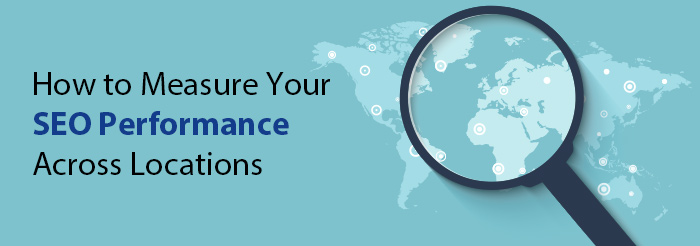How to Measure Your SEO Performance Across Locations
Posted on
Multi-location healthcare practices face several challenges when defining their local SEO strategies and evaluating their SEO performance.
You can’t manifest scalable growth without a strategy for evaluating location-specific SEO performance. This is particularly true of multi-location practices, who should measure and compare SEO performance between locations.
To accurately evaluate the performance of multi-location practices, you need to understand key performance indicators (KPIs) at each specific location. Without this information, you won’t know if you are maintaining performance across locations as you grow. He are three essential steps that will help you measure SEO performance across different regions.
Step 1: Establish Consistent KPIs
These can vary based on what is most important to your practice stakeholders. Consider your metrics and divide them into three main categories: visibility, Search Engine Results Page (SERP) actions, and conversions.

Common visibility metrics include:
- Local keyword rankings for high-priority queries
- Google Business Profile views for each local listing
- Yext views for business listings outside of Google
- Google Search Console impressions for sitewide SERP
SERP actions worth tracking include:
- Customer actions on Google Business Profile (phone calls, direction requests, and website visits coming through Google local business listings)
- Referral traffic from off-site listings to ensure you track consistently within Google Analytics
- Google Search Console clicks for organic listings
Conversion metrics include:
This is the most critical KPI for your SEO. In healthcare practices, the most important conversion metric is booking an online or phone appointment. When you track this and the other actions above, you’ll gain a better sense of which channels your patients are coming from and where you should market more strategically to create higher-quality conversions. Setting up click-to-call conversion tracking is one of the best methods of tracking the effectiveness of your local SEO strategy. It’s always good to see an increased conversion rate when you roll out local SEO optimizations. If your conversion rate is up, you’re reaching your target local audiences.

Finally, one more obvious KPI you should track is your average Google review rankings over time. This can make or break your local presence, so staying on top of your reviews is crucial.
Step 2: Choose the Right Analytics Tools
With so many analytics tools available, it’s much easier to focus on these four essentials:
1. Google Business Profile (formerly Google My Business/GMB): Google generates more than 89 billion searches per month. That’s why it’s critical for you to be visible across the entire SERP—including within Google’s Map Pack/Local Pack and your Google business listing. Healthcare practices should appear within organic listings and local listings to maximize exposure to prospective patients.
Monitor any increase in total actions on your GBP listings including phone calls, direction requests, and website visits. When you see an increase in interactions, it means you’re reaching people who need your services.

Your interaction numbers will be closely correlated with search impressions. When you see an increase in non-brand impressions, it means that your practice has been appearing on more general, local searches without the user having to look up your practice by name.
2. Google Analytics: This is most often the primary source of factual website data, and it offers many valuable tools meant for locally focused healthcare practices. For these businesses, Google’s geographic reports reveal where your traffic is coming from. For example, if you service a certain area but you’re seeing website traffic from an area 40 miles away, you need to update your local SEO strategy so it focuses more specifically on the entire area you service.

The best local SEO services will add targeted location language on your website and location page. You can cross-reference this data with impressions in Google Search Console or query reports from your GBP. Identify which searches are drawing people to your website. Ask yourself what value you can provide to those users who are located far away from your office.

Google’s geo reports can reveal unexpected new serviceable areas. If your geo report reveals traffic from a serviceable area that you’re not currently targeting, you have a great opportunity to take advantage of a new market. You can then target that area in your web content and GBP optimizations.
3. Local Falcon: This is a lesser-known analytics tool that helps you see your average ranking within a set radius around your practice location. Like a Google Analytics geo report, this data can help you determine which of your local markets need a more strategic approach to generate greater demand.
Your Local Falcon ranking results can be compared to competitors to identify where they’re outpacing your practice. Do they have more or better online reviews? Are they located closer to the search area? Do they use keywords in their Google local business listing that you can emulate? You can also generate trend reports over time to see how your listing improves in ranking as you make adjustments.
4. SEMRush: Local Falcon is good for competitive research, but SEMRush is essential for comprehensive rank tracking and keyword research. SEMRush keyword research tools can identify the most valuable keywords in your local markets, then add those to your location projects to track rankings in your specific locale.
Step 3: Understand the Challenges of SEO for Multiple Locations
There are three main challenges you’ll likely encounter as you grow and expand your practice into new locations:
- Which locations should you prioritize? Consider that each location is unique and requires different tactics for driving organic traffic. Which markets are interested in which of your specific services? With Google Analytics and local search volume reports from SEMrush, you can see where traffic and conversions are coming from at local levels. By understanding where most users are coming from, you can focus on location-specific keywords, local business schema, and creating an optimized Google listing.
- How do target keywords differ between locations? For multi-location practices, search queries will vary from location to location. By identifying competitors in each of your target areas and understanding how SERPs change from location to location, you can then create location pages that rank well in your target areas.
- How do you track KPIs and implement keyword optimizations? Tracking many keywords for many locations quickly becomes complicated. So, the first step is prioritizing markets according to your KPIs. Start your optimization strategy with up to ten markets and use them as testing grounds. Analyze their performance for several months before rolling out any additional location pages or local listings. Then prioritize your keywords and services. Choose a strategic selection of keywords for tracking. Make sure you’re considering local and national search volumes, as well as business value and relevance.
Use an Integrated SEO Dashboard
Integrated SEO dashboards let you see all your data in one place. You can see all your local markets at once or focus on a specific location within the same dashboard. Google Analytics Dashboards will dynamically update as you make changes.
Remember that multi-location SEO is a continuous process that you can improve and optimize as your practice continues expanding to new locations. Your multi-location SEO strategy is a living, breathing structure that you can rely on to sustain practice growth. With the right metrics, tools, and a better understanding of the challenges you face in a multi-location health practice, you can achieve sustainable growth.
To learn more about multiple locations SEO and growing your practice with it, connect with our SEO experts at Practice Builders – the best healthcare marketing agency.

 What Are the First Steps When Planning a New Websi..
What Are the First Steps When Planning a New Websi.. SEO Strategies to Rank Your Dental Practice
SEO Strategies to Rank Your Dental Practice How AI is Driving Patient Engagement and Revolutio..
How AI is Driving Patient Engagement and Revolutio..